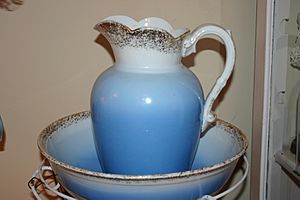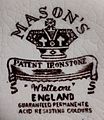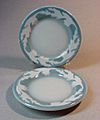Ironstone china facts for kids
Ironstone is a special kind of pottery. It's a strong, glazed (or glassy) type of ceramic that was first made in the United Kingdom in the early 1800s. It's not quite earthenware, but it's very similar to fine stoneware.
Even though it's called "ironstone," it doesn't actually contain any iron! It got its name because it's super strong and lasts a long time. Potters in Staffordshire, England, created ironstone in the 19th century. It quickly became popular because it was a cheaper option than fancy porcelain.
Contents
The History of Ironstone Pottery
Ironstone was first made in Britain's Staffordshire potteries. Charles James Mason received a special patent for his ironstone in 1813. Soon, the name "ironstone" became common for this type of pottery.
Mason's Famous Creations
Because Mason's ironstone was so strong, the company could make very large decorative items. They even made huge vases for hallways that were 1.5 meters (about 5 feet) tall! Fireplace mantelpieces were also made from several big ironstone pieces.
Mason's tableware was very popular. It was used in many hotels and restaurants, as well as in people's homes. Businesses often had their name printed onto the ironstone dishes.
Other Important Makers
Mason's wasn't the only company making ironstone. Another high-quality pottery company was Spode. They started making ironstone as early as 1805. Spode sent a lot of their ironstone to France. In France, people often preferred ironstone over another type of pottery called faience.
Ironstone's Popularity in America
By the mid-1800s, the United States became the biggest customer for Staffordshire's potteries. Americans bought huge amounts of plain white ironstone.
Today, old ironstone pieces are popular with collectors. Items made by Mason's are especially sought after.
Images for kids
-
A Syracuse China example of mid-20th-century restaurant ware. This is ironstone china made for restaurants.





